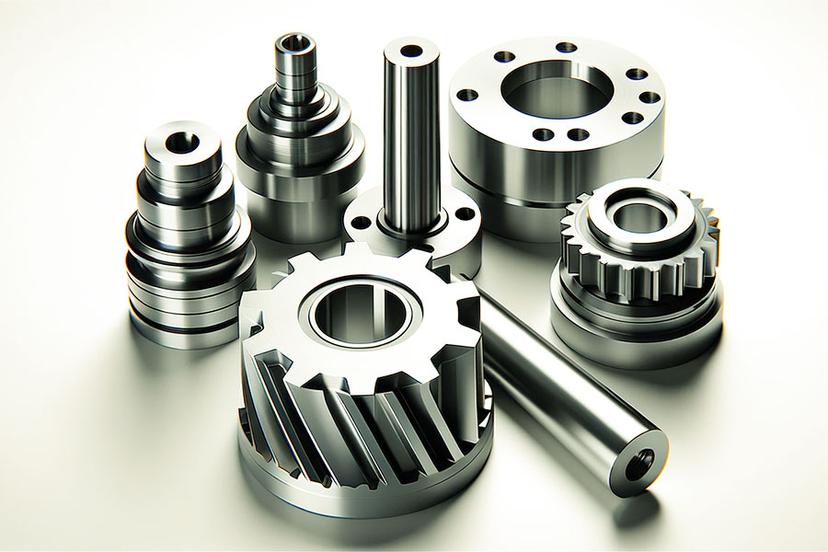CNC machining has gained significant market sharein the manufacturing world in recent years due to its excellent accuracy and reproducibility. In this day and age, there are many types of CNC technology, and an in-depth exploration of the basic principles of CNC machining can allow you to more clearly identify their respective characteristics.CNC turning technology can be considered an innovative breakthrough. This process mainly uses non-rotating cutting tools to remove material from rotating rigid workpieces through turning centers and lathes. CNC turning technology can produce parts of various shapes and sizes depending on the specific cutting method. Although the concept may appear visually simple, high-qualityCNC turning technology can have considerable complexity. Suppose you are interested in exploring the elements required for this production process and want to know how to achieve optimal results. In the current environment, this article will comprehensively answer every question you have about CNC turning.
What is CNC Turning?
CNC turning uses computer programsand advanced CNC technology to precisely control the movement of the lathe, allowing the cutting tool to cut along a predetermined trajectory on the rotating workpiece, thereby removing excess material and obtaining parts of the required shape and size.

What are the advantages and disadvantages of CNC turning?
CNC turning is an advanced machining technology that uses computer programming to control machine tools for precise turning operations. The following table shows theadvantages and disadvantages of CNC turning:
| Advantages | Disadvantages |
| CNC turning eliminates human error through the use of CAD and CAD software, thus producing accurate parts. | CNC lathes are expensive to set up and maintain. |
| Turning centers are compatible with a variety of materials and different sized parts, providing flexibility in manufacturing. | CNC lathe processing has size restrictions and may not be able to accommodate very large workpieces. |
| CNC lathes are efficient and fast, getting parts to market on time without compromising on quality. | Since turning is a subtractive machining method, it generates a large amount of waste. |
| Furthermore, CNC turning is a precise method as it ensures consistency in production batches. | |
| Turning is a safe process as it is completely enclosed to prevent material from flying around. |
What are the common types of CNC lathes?
There are four maintypes of CNC lathesyou can use for your projects. They include horizontal turning centers, vertical turning centers, horizontal lathes, vertical lathes. Now the Longsheng team will introduce these four types in detail to you.
Horizontal turning center
It is a closed machine using a horizontal spindle. As the workpiece rotates, the cutting tool shapes it. It is more suitable for longer and cylindrical parts. ThisCNC turning center is not affected by gravity. As a result, chips accumulate around the cutting tool and may be difficult to remove. This machine type can be used to make precision tools and custom automotive parts.
Vertical turning center
Here, the workpiece is located on the vertical spindle. Cutting tools also work vertically to machine parts in an upward or downward direction. This type is suitable for complex parts as it combines additional milling and drilling capabilities. It has wide use in structural applications and creating prototypes for experimental purposes. The vertical orientation of this machine type facilitates easy chip removal and speeds tool changes.
Horizontal lathe
Here, since the spindle is in a horizontal position, the workpiece is placed parallel to the ground. The machine has small load-bearing capacity and limited rigidity, making it suitable for processing small and medium-sized components. It enables tight tolerances when producing electrical accessories and medical equipment.
Vertical lathe
In contrast to a horizontal lathe, the spindle here is in a vertical position. This is a perfect option for workshops with limited space. The machine has excellent load-bearing capacity and is suitable for processing heavy components such as ship and wind turbine components. The vertical setup adds flexibility to machining practices and can accommodate varying space and weight requirements.

What are the commonly used materials for CNC turning?
Thematerials most suitable for CNC turningcover many categories such as metal, plastic, wood, glass, etc., but the specific selection needs to be comprehensively considered based on factors such as processing needs, material properties, and processing costs.
Metal
- Aluminum alloy:lightweight and high strength, with good thermal conductivity and corrosion resistance, commonly used in aerospace, automobiles, electronic products and other fields. In CNC turning, aluminum alloy has excellent cutting performance and high processing efficiency.
- Stainless steel:It has excellent corrosion resistance and high temperature strength and is widely used in kitchenware, medical equipment, chemical containers, etc. Although the hardness is relatively high, stainless steel can also achieve efficient CNC turning by selecting appropriate tools and cutting parameters.
- Carbon steel:high strength and hardness, good wear resistance, often used in the manufacture of mechanical parts and tools. In CNC turning, carbon steel has stable processing performance and is suitable for manufacturing various precision parts.
- Titanium alloy:high strength and low density, excellent corrosion resistance and high temperature performance, commonly used in aerospace, medical and other fields.CNC turning of titanium alloysis difficult, but high-precision machining can also be achieved by selecting appropriate tools and process parameters.
Plastic
- ABS plastic:readily available raw materials, good overall performance, cheap, widely used, tough and hard, suitable for CNC turning.
- Nylon (PA):Strong, wear-resistant, self-lubricating, with a wide operating temperature range. It is often used to replace copper and non-ferrous metals in the production of mechanical, chemical and electrical parts. Nylon materials are also suitable for CNC turning.
- Polyacetal resin (POM):high hardness, light weight, high rigidity, and high wear resistance. It is commonly used in the manufacturing of gears, bearings, auto parts, etc. POM materials are also suitable for CNC turning.
Wood
A natural material with certain strength and toughness, suitable for furniture, decoration and other fields. In CNC turning, the processing performance of wood is good, and various complex shapes can be processed.
Glass
Although glass is traditionally considered difficult to process, with the continuous development of CNC technology, glass CNC machining technology has been able to achieve high-precision and complex shape processing. Glass CNC machining is widely used in architectural decoration, furniture manufacturing, automobile industry and other fields.

What are the applications of CNC turning?
CNC turning, that is, computer numerical control turning, is an advanced machining technology that controls the machine tool to cut along a designated path through a pre-written processing program. CNC turning is widely used in many fields. The following are its main application areas:
1. Aerospace
In the aerospace field, there are extremely high requirements for the accuracy and reliability of components. CNC turning technology can meet these needs and achieve precise machining of complex parts. For example, high-precision and high-strength parts such as aircraft engine turbine blades and fuselage structural parts can be manufactured through CNC turning technology.
2. Automobile manufacturing
During the automobile manufacturing process, a large number of parts need to be processed, and these parts often have complex geometric shapes and high precision requirements. CNC turning technology can achieve efficient and high-precision processing and improve production efficiency. For example, automobile engine parts, transmission parts, braking systems, etc. can all be manufactured through CNC turning technology.
3. Medical equipment
The manufacturing of medical equipment also has extremely high requirements for precision and reliability.CNC turning technology can be used to manufacture high-precision medical devices, such as surgical instruments, implants, etc. Especially for some customized medical parts, CNC turning technology can accurately produce them according to the needs of patients.
4. Electronic product
In the field of electronic products, CNC turning technology is also widely used. For example, precision parts inside electronic products such as mobile phones and laptops, such as casings, motherboards, heat sinks, etc., can be manufactured with high precision through CNC turning technology. The dimensional accuracy and surface quality of these parts are critical to the performance and reliability of electronic products.
5.Mold making
Mold manufacturing is an integral part of the manufacturing industry. CNC turning technology can accurately process various parts of the mold, ensuring the accuracy and life of the mold. This is of great significance for improving the manufacturing quality of molds and reducing production costs.
6.Oil and gas industry
Precision CNC turning helps in the manufacture, repair and maintenance of parts for heavy machinery in the oil and gas industry. It is the most reliable and accurate method for manufacturing parts such as pins, pistons, rods and cylinders.

What are the cost differences between CNC turning and manual turning?
In this section, we will show you thecost differences between manual turning and CNC turning. The main cost differences are as follows:
material cost
There is not much difference in material cost between manual turning and CNC turning, as both require materials to complete the machining. Regardless of the machining method used, the price of the material remains unchanged. However, CNC turning can provide higher accuracy, which means that if CNC turning is used, less material may be wasted. This can save some costs.
Machine cost
There is a significant cost difference between manual turning andCNC turning machines. CNC turning requires specialized equipment for machining, while manual turning does not require additional equipment and only requires manual operation. Therefore, the equipmentcost of CNC turningis significantly higher than that of manual turning. Nevertheless, CNC turning has higher efficiency and significantly improved production efficiency compared to manual turning.
Labor costs
manual turning requires more manual labor participation, therefore more personnel salaries need to be paid. CNC turning requires a small number of operators to control the machine. Compared to manual turning,CNC turning can better control labor costs.
What is the difference between CNC turning and CNC milling ?
CNC milling andCNC turningare two common cutting processes that differ significantly in many aspects. The following table is a specific comparison of these two processes:
| CNC Milling | CNC Turning | |
| Method | Rotates cutting tool at pre-set RPM | Rotates workpiece at pre-set RPM |
| Result | Flat or sculptured | Cylindrical or conical |
| Machine | Milling machine | Lathe |
| Tool | Multi-point cutting tool | Single point turning tool |
| Contact | Cutting tool cuts intermittently during operation | Cutting tool remains in continuous contact withworkpiece during operation |
| Movement | Workpiece moves | Cutting tool moves |
| Waste | Produces discontinuous chips | Produces fragmented,discontinuous, or continuouschips |
Why use LS as your CNC turning service?
After deciding whether CNC turning is best for your project, the next step is to find a trusted partner to help turn your ideas into reality. From rapid prototyping to volume production, we're here to support you every step of the way in product development.
With highly skilled engineers and machinists on staff, we ensure your parts meet the highest quality standards. We support quick quotation within 2 hours. Have more than 15 years of CNC machining experience. We support large-scale customization services. Production equipment: 75 units. The factory covers an area of 3000 square meters. The tolerance is controlled within 0.02mm. We have a project plan and timeline, a three-day lead time, and the ability to handle rush orders. If you have any needs,please let us knowand we can produce everything you want according to the drawings you provide.

Summary
As a high-precision, high-efficiency, flexible and automated manufacturing process,CNC turning has broad application prospectsand significant advantages in the manufacturing industry. In the future, with the continuous innovation and improvement of technology, CNC turning will inject new vitality into the development of manufacturing industry and promote the manufacturing industry to move to a higher level.
Disclaimer
The content on this page is for reference only.Longshengdoes not make any express or implied representation or warranty as to the accuracy, completeness or validity of the information. No performance parameters, geometric tolerances, specific design features, material quality and type or workmanship should be inferred as to what a third party supplier or manufacturer will deliver through the Longsheng Network. It is the responsibility of the buyerseeking a quote for partsto determine the specific requirements for those parts.Pleasecontact usfor moreinformation.
LS Team
This article was written by multiple Longsheng contributors. Longsheng is a leading resource in the manufacturing sector, withCNC machining,sheet metal fabrication,3D printing,injection molding,metal stamping, and more.






